| |
|
|
| |
Good enough to eat.
Fri 26th July, 2013
|
|
|
|
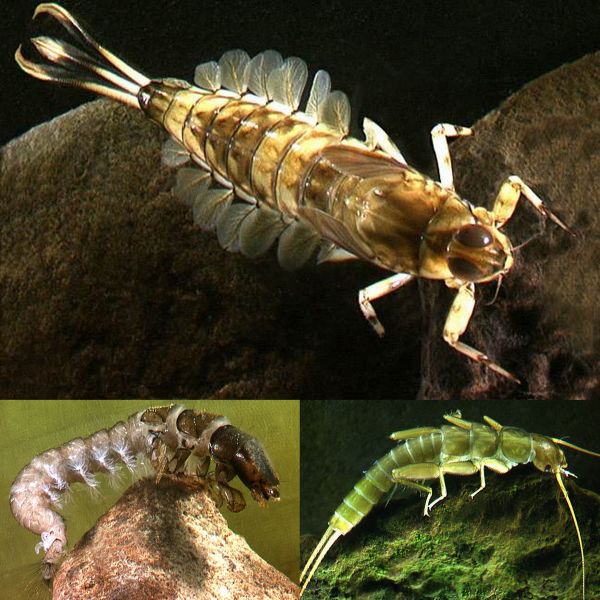 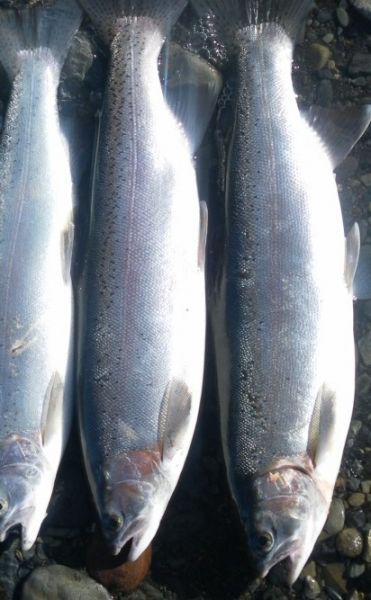 Unlike their salmon relatives steelhead trout continue to feed while they're in the rivers and streams, although I doubt they know what's good enough to eat and what's not when they first enter the river. Unlike their salmon relatives steelhead trout continue to feed while they're in the rivers and streams, although I doubt they know what's good enough to eat and what's not when they first enter the river.
Fish moving through the lower stretches or fish that haven't been in the river that long are generally easier to catch and if you drift anything that looks remotely edible past their noses, chances are they'll have a go at it.
American anglers have a great name for these fresh run fish. They call them " chromers " which describes the beautiful bluey silver color they exhibit when they first leave the lake.
When rainbows migrate up the rivers to spawn they have to switch from their " lake diet " which consists mostly of smelt and adjust to what they find in their new environment. They haven't learned yet what's good and what's not ... so fly choice isn't that important.
By the time they get past the town pools they're already beginning to recognize that the dark shadows moving outside the water spell danger. And so do the things that splash into the river when ever the shadows are around.
This is a totally opposite response to the one you'll observe in a fish farm, for instance when a member of staff approaches a stock pond carrying a feed bucket. Instead of fleeing the trout will actually swim towards him. Even before the pellets are thrown into the water they'll move towards the surface jockeying for the best position because in this instance they've learned that any movement above them isn't a threat and usually means food.
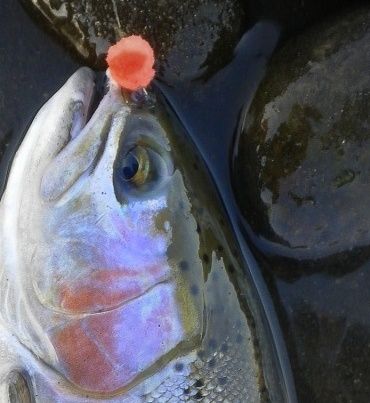
Rainbows seem naive and impulsive when they first leave the lake but their natural survival instincts soon kick in as they migrate upriver past an ever growing number of anglers.
Brightly colored glo bugs and attractor patterns all work well at first but as the weeks go by the fish become a little more selective and the takes are far less aggressive.
Although they don't feed as often they'll continue to eat until the spawning urge becomes so strong, it overrides everything else. Now male trout will often strike at flies when they're defending spawning sites but not because they're feeding.
Their cousins the salmon die after they've spawned but many rainbows survive and embark on a feeding bender which helps start the process of regaining the weight and condition they lost during spawning.
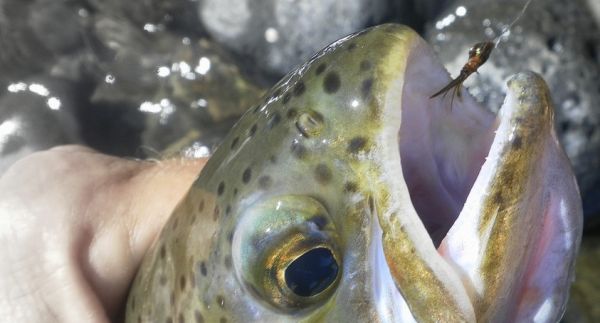
As they gradually make their way back to the lake these recovering kelts provide excellent spring and summer sport on the Tongariro and can be caught on all methods. Some of them stay on and become " resident " trout but by now they've adapted to life in the river and the fairly crude tactics we use in winter are no longer effective. Now anglers also have to adapt and use lighter tackle, small natural patterns and a more thoughtful approach to deceive them.
When you hear anglers talking about using " naturals " on the Tongariro they are usually referring to the nymphal or larval stage of the aquatic insects that trout eat. These are always fished below the surface using a method called nymphing.
Most rivers and streams contain the big three, Mayflies, Caddis and Stoneflies. Although you don't have to be an entomologist to catch trout during the spawning runs on the Tongariro. If you're able to recognize these three types of aquatic insects and learn a little bit about their habitat and life cycle it will help increase your catch rate when the going gets tough.
Its now easier than ever before to improve our knowledge and understanding of just about anything. Ever since personal computers became available during the latter part of the 1970's, the birth of the Internet a few years later, spawned a worldwide information revolution shared between billions of users. Now websites covering every subject under the sun are just a click away and there are an estimated 250 million registered domain names out there.
For example the fantastic insect photography in this weeks report is courtesy of Stephen Moore from www.landcareresearch.co.nz a web-site that all fly fishermen will find useful.
If you're new to fly fishing its easy enough to distinguish between caddis larvae and the nymphs of mayfly or stonefly because they look so different. Caddis larvae resemble grubs or caterpillars and look nothing like the adult flies they will eventually become { complete metamorphosis }. The nymphs on the other hand already have characteristics of their adult forms and never enter a pupal stage
{ incomplete metamorphosis }.
But some mayfly and stonefly nymphs have very similar body shapes and when you first begin to take an interest in this aspect of fly fishing its easy to get them mixed up. Its not so bad when you can clearly see and compare them through a microscope or something. Then details like those in the photographs stand out, for example the position or shape of of the gills.
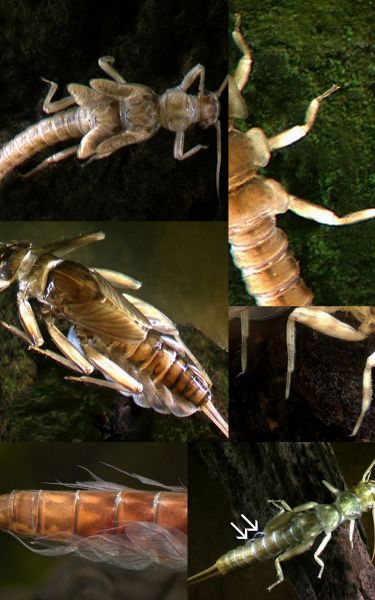
So what's the best way to tell these two nymphs apart when your standing in the river turning over a few rocks and you haven't got a microscope in your vest pocket?
If it has three tails its a mayfly because stonefly only have two. Unfortunately you can't rely on this alone because some mayfly also only have two tails or in some cases a very short middle tail.
What other clues can you look for.
Well ... as far as I know there are two differences in their anatomy that are specific to each insect. One is fairly easy to spot with the naked eye. Although if you have naked eyes like mine you'll definitely have to put your glasses on. The other you probably won't make out without the aid of a magnifying glass.
First of all check out the wing cases. Stonefly nymphs have two very obvious wing pads on top of the thorax. Something to keep in mind when you start tying your own. Mayfly nymphs only have one.
Secondly look at the very tip of the legs. Stoneflies always have two claws on the end of each "foot" these help them cling to the underside of rocks in the fast riffles where you usually find them.
Again mayflies only have one.
So is all this swotting up going to turn you into a fish catching machine who snags a fish every other cast ... no of course it won't. But it will help you make better guesstimates of what trout may be feeding on at different times in different parts of the river. So already you're not just hoping for the best and chucking and chancing anymore.
When we're nymphing, a lot of the time we're fishing blind and can't see the fish or what they're eating. We have to make an educated guess at whats happening below the surface.
Its by no means a hard and fast rule but if you're able to recognize that there is an abundance of a particular insect, or stage in that insects life cycle in the stretch you're fishing, then tying on a fly that imitates it is probably a good place to start.
If you're just starting out fly fishing don't worry too much at this stage about filling your fly-box with hundreds of patterns. Believe me you'll catch that disease soon enough.
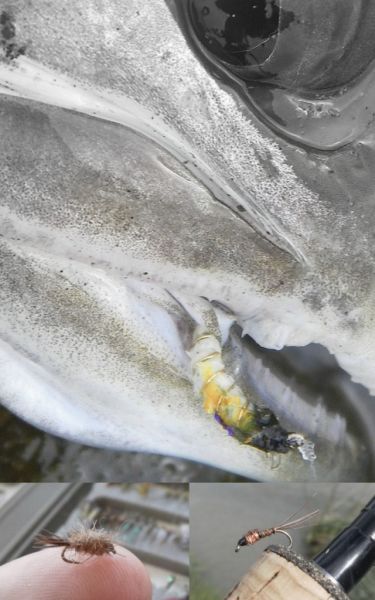
I'm confident that if you had to, you could literally nymph with just three flies on the Tonagriro. And providing you had them tied in various sizes and used them in the right circumstances you'd do pretty well.
No prizes for guessing what they are ... the Hare and Copper, Pheasant Tail and some sort of Caddis.
The Hare and Copper is the " great imitator " and in different sizes will pass for many of the invertebrates you're likely to find in the river.
Similarly the Pheasant Tail does a great job of mimicking various mayfly nymphs especially some of the smaller swimming varieties.
And if you're fishing riffles and runs a well presented caddis larvae will often get a trouts attention.
The fly fishing journey is a long one so take your time and enjoy it. When I think about it none of us will ever learn it all anyway. Learning to fly fish is a bit like building a house by laying a couple of dozen bricks a year ... one lifetime just ain't going to do it.
Talking of houses I've got to swop my fly rod for a paintbrush on and off for the next couple of weeks. The foreman has given me strict instructions that I'm not allowed to go fishing until I've finished ... yeah right !
I wear the trousers in this house and I've got her just where she wants me.
See you in my tea-break.
Tight lines guys
Mike. |
|
|
| Back to Top |
|
|
|
|
|
|
|